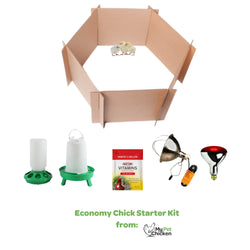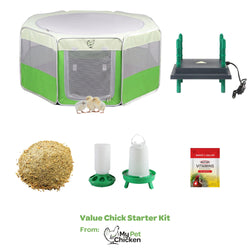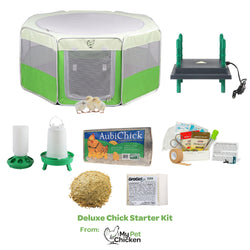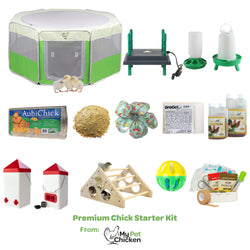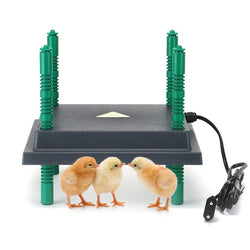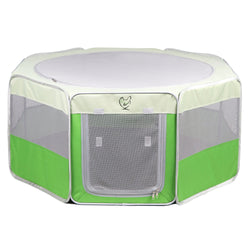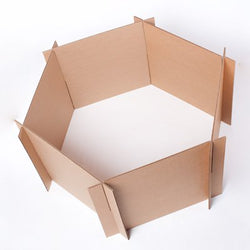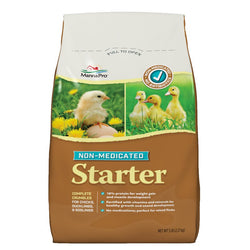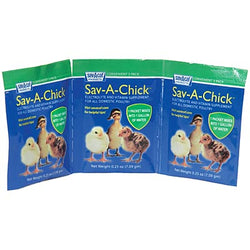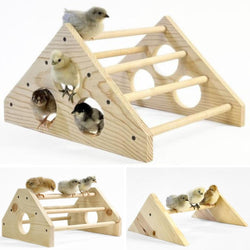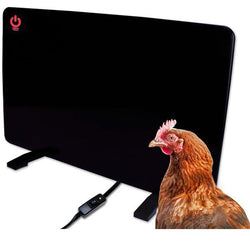What do I need to know about wolves and coyotes if I keep chickens?
Back to blog
Name:
Wolf, Coyote
Canis lupus, Canis latrans
Description:
Wolves and coyotes are both members of the dog family, and appear as large (scary!) dogs with silvery or brownish fur.
Wolves can be up to 5 feet long (excluding tails), and nearly three feet tall at the shoulder. They can weigh up to 175 pounds, but average around 80.
Coyotes can be up to about 3 feet long (excluding the tail), and about 2 feet tall at the shoulder. They can weigh up to 75 pounds, but average around 50.

Distribution/Habitat:
Coyotes are found in North America. Various species of wolves are found primarily in the Northern hemisphere.
Hunting Behavior:
Wolves generally hunt in packs. Coyotes may sometimes hunt singly or in pairs. However, you will probably rarely actually see any take your birds. They tend to avoid humans, so the evidence they leave will be remarkably similar.
Wolves and coyotes will eat what they kill, in contrast to domestic dogs that kill accidentally, or for the fun of the chase. These wild canids prefer to break the neck with vicious bites, but they may grab whatever they can of a fleeing chicken. They prefer to single out the old, the young and the weak, so those will be taken preferentially. They have a good ability to be able to distinguish the slowest in your flock.
When killed by coyotes or wolves (or feral dogs), if you find remains, your chickens will usually be disemboweled and mostly eaten. There may be puncture wounds from teeth in what remains of the body. However, chickens are small enough that they will usually be carried off to eat elsewhere, so it may be hard to tell if your birds were killed by wolves, coyotes or foxes. If your birds are stolen from a secure run, foxes will most often sneak in or climb over, rarely digging. If they do dig, foxes will dig smaller holes since they don't need as much space to squeeze through. Wolves or coyotes require a large opening to get in.
Protecting Your Flock
Wolves and coyotes are fairly uncommon predators of chickens, so you are unlikely to have predation by these creatures. They tend to avoid areas of human habitation, wolves especially. Plus, since they hunt at night, if your birds are securely locked in their coop, you will probably have no problems with them.
With that said, if there is a food shortage in their area and they get hungry, it is possible they might venture out in the day time. Double check that any wire mesh on your coop is securely attached, because if they want in, wolves and coyotes will simply muscle through areas with weak points. They will find holes in your fence, or areas where the fence does not meet the ground. They can jump low fences 4 feet tall, and sometimes higher, but they will rarely climb a very tall fence. To exclude wolves and coyotes, be sure your fence is strong and 5 1/2 or 6 feet tall. For further security from digging, make sure to bury the fence about a foot deep, or to create an apron. Small runs may be completely enclosed on the bottom to keep your flock safe from diggers.
Remember: don't use chicken wire for your coop or run: chicken wire is not a barrier to predators. Wolves, coyotes and other predators can tear right through it like tissue paper. (Chicken wire should only be used to keep chickens in, not to keep predators out.) Ideally, use welded wire fencing or hardware cloth.
Unlike some other common predators, wolves and coyotes don't reach through fence openings with paws that are able to grasp your chickens and pull parts of them out (although if the openings are big enough, they might wedge their heads through and snap with their teeth). For that reason, a strong and tall welded wire or chain link fence will work to exclude them. However, since there are many other predators you need to exclude such as raccoons foxes, opossums and the like, you will want to use a fine mesh hardware cloth (usually 1/2" or 1/4") that will keep out smaller predators, too.
Wolf, Coyote
Canis lupus, Canis latrans
Description:
Wolves and coyotes are both members of the dog family, and appear as large (scary!) dogs with silvery or brownish fur.
Wolves can be up to 5 feet long (excluding tails), and nearly three feet tall at the shoulder. They can weigh up to 175 pounds, but average around 80.
Coyotes can be up to about 3 feet long (excluding the tail), and about 2 feet tall at the shoulder. They can weigh up to 75 pounds, but average around 50.

Distribution/Habitat:
Coyotes are found in North America. Various species of wolves are found primarily in the Northern hemisphere.
Hunting Behavior:
Wolves generally hunt in packs. Coyotes may sometimes hunt singly or in pairs. However, you will probably rarely actually see any take your birds. They tend to avoid humans, so the evidence they leave will be remarkably similar.
Wolves and coyotes will eat what they kill, in contrast to domestic dogs that kill accidentally, or for the fun of the chase. These wild canids prefer to break the neck with vicious bites, but they may grab whatever they can of a fleeing chicken. They prefer to single out the old, the young and the weak, so those will be taken preferentially. They have a good ability to be able to distinguish the slowest in your flock.
When killed by coyotes or wolves (or feral dogs), if you find remains, your chickens will usually be disemboweled and mostly eaten. There may be puncture wounds from teeth in what remains of the body. However, chickens are small enough that they will usually be carried off to eat elsewhere, so it may be hard to tell if your birds were killed by wolves, coyotes or foxes. If your birds are stolen from a secure run, foxes will most often sneak in or climb over, rarely digging. If they do dig, foxes will dig smaller holes since they don't need as much space to squeeze through. Wolves or coyotes require a large opening to get in.
Protecting Your Flock
Wolves and coyotes are fairly uncommon predators of chickens, so you are unlikely to have predation by these creatures. They tend to avoid areas of human habitation, wolves especially. Plus, since they hunt at night, if your birds are securely locked in their coop, you will probably have no problems with them.
With that said, if there is a food shortage in their area and they get hungry, it is possible they might venture out in the day time. Double check that any wire mesh on your coop is securely attached, because if they want in, wolves and coyotes will simply muscle through areas with weak points. They will find holes in your fence, or areas where the fence does not meet the ground. They can jump low fences 4 feet tall, and sometimes higher, but they will rarely climb a very tall fence. To exclude wolves and coyotes, be sure your fence is strong and 5 1/2 or 6 feet tall. For further security from digging, make sure to bury the fence about a foot deep, or to create an apron. Small runs may be completely enclosed on the bottom to keep your flock safe from diggers.
Remember: don't use chicken wire for your coop or run: chicken wire is not a barrier to predators. Wolves, coyotes and other predators can tear right through it like tissue paper. (Chicken wire should only be used to keep chickens in, not to keep predators out.) Ideally, use welded wire fencing or hardware cloth.
Unlike some other common predators, wolves and coyotes don't reach through fence openings with paws that are able to grasp your chickens and pull parts of them out (although if the openings are big enough, they might wedge their heads through and snap with their teeth). For that reason, a strong and tall welded wire or chain link fence will work to exclude them. However, since there are many other predators you need to exclude such as raccoons foxes, opossums and the like, you will want to use a fine mesh hardware cloth (usually 1/2" or 1/4") that will keep out smaller predators, too.
